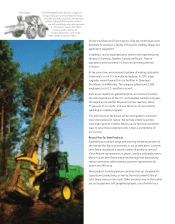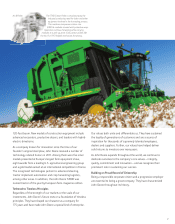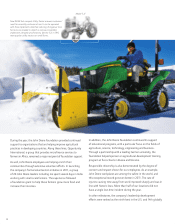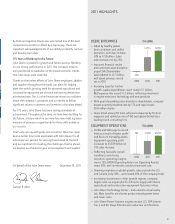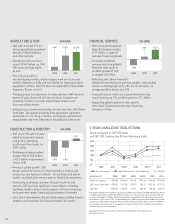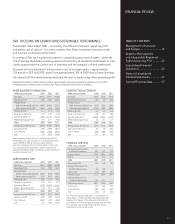John Deere 2011 Annual Report Download - page 16
Download and view the complete annual report
Please find page 16 of the 2011 John Deere annual report below. You can navigate through the pages in the report by either clicking on the pages listed below, or by using the keyword search tool below to find specific information within the annual report.
Net sales outside the U.S. and Canada increased by 14 percent
in 2010, which included a favorable effect of 5 percent for
foreign currency translation.
Worldwide equipment operations had an operating
profit of $2,909 million in 2010, compared with $1,365 million
in 2009. The higher operating profit was primarily due to
higher shipment and production volumes, improved price
realization, the favorable effects of foreign currency exchange
and lower raw material costs, partially offset by increased
postretirement costs and higher incentive compensation expenses.
The results in 2009 were also affected by a goodwill impairment
charge and voluntary employee separation expenses.
The equipment operations’ net income was $1,492 million
in 2010, compared with $677 million in 2009. The same
operating factors mentioned above affected these results.
Net income of the company’s financial services operations
attributable to Deere & Company in 2010 increased to
$373 million, compared with $203 million in 2009. The increase
was primarily a result of improved financing spreads and a lower
provision for credit losses. Additional information is presented in
the following discussion of the “Worldwide Financial Services
Operations.”
The cost of sales to net sales ratio for 2010 was 73.8 percent,
compared with 78.3 percent in 2009. The decrease was
primarily due to higher shipment and production volumes,
improved price realization, favorable effects of foreign currency
exchange and lower raw material costs. A larger goodwill
impairment charge and voluntary employee separation expenses
affected the ratio in 2009.
Finance and interest income decreased in 2010 due to
lower financing rates, partially offset by a larger average portfolio.
Other income increased primarily as a result of an increase in
wind energy income, higher commissions from crop insurance
and higher service revenues. Research and development
expenses increased primarily as a result of increased spending in
support of new products including designing and producing
products with engines to meet more stringent emissions
regulations. Selling, administrative and general expenses
increased primarily due to increased incentive compensation
expenses, higher postretirement benefit costs and the effect of
foreign currency translation. Interest expense decreased due to
lower average borrowing rates and lower average borrowings.
Other operating expenses increased primarily due to the
write-down of wind energy assets classified as held for sale in
2010 (see Note 4). The equity in income of unconsolidated
affiliates increased as a result of higher income from construc-
tion equipment manufacturing affiliates due to increased levels
of construction activity.
The company has several defined benefit pension plans
and defined benefit health care and life insurance plans.
The company’s postretirement benefit costs for these plans in
2010 were $658 million, compared with $312 million in 2009,
primarily due to a decrease in discount rates. The long-term
expected return on plan assets, which is reflected in these costs,
was an expected gain of 8.2 percent in 2010 and 2009, or
$883 million in 2010 and $857 million in 2009. The actual
return was a gain of $1,273 million in 2010 and $1,142 million
in 2009. Total company contributions to the plans were $836
million in 2010 and $358 million in 2009, which include direct
benefit payments for unfunded plans. These contributions also
included voluntary contributions to total plan assets of approxi-
mately $650 million in 2010 and $150 million in 2009.
BUSINESS SEGMENT AND GEOGRAPHIC AREA RESULTS
Worldwide Agriculture and Turf Operations
The agriculture and turf segment had an operating profit of
$2,790 million in 2010, compared with $1,448 million in 2009.
Net sales increased 10 percent in 2010 primarily due to higher
production and shipment volumes. Sales also increased due to
foreign currency translation and improved price realization.
The increase in operating profit was due to increased shipment
and production volumes, improved price realization, the
favorable effects of foreign currency exchange and lower raw
material costs, partially offset by higher postretirement benefit
costs and increased incentive compensation expenses.
The results in 2009 were affected by a goodwill impairment
charge and voluntary employee separation expenses.
Worldwide Construction and Forestry Operations
The construction and forestry segment had an operating profit
of $119 million in 2010, compared with a loss of $83 million in
2009. Net sales increased 41 percent in 2010 due to higher
shipment and production volumes. The operating profit
improvement in 2010 was primarily due to higher shipment and
production volumes, partially offset by higher postretirement
benefit costs and increased incentive compensation expenses.
Worldwide Financial Services Operations
The operating profit of the financial services segment was
$499 million in 2010, compared with $242 million in 2009.
The increase in operating profit was primarily due to improved
financing spreads and a lower provision for credit losses.
Total revenues of the financial services operations, including
intercompany revenues, increased 1 percent in 2010, primarily
reflecting the larger portfolio. The average balance of receiv-
ables and leases financed was 5 percent higher in 2010,
compared with 2009. Interest expense decreased 28 percent in
2010 as a result of lower borrowing rates and lower average
borrowings. The financial services operations’ ratio of earnings
to fixed charges was 1.77 to 1 in 2010, compared with 1.26 to
1 in 2009.
Equipment Operations in U.S. and Canada
The equipment operations in the U.S. and Canada had an
operating profit of $2,302 million in 2010, compared with
$1,129 million in 2009. The increase was due to higher
shipment and production volumes, improved price realization
and lower raw material costs, partially offset by increased
postretirement benefit costs and higher incentive compensation
expenses. The operating profit in 2009 was affected by a
goodwill impairment charge and voluntary employee separation
expenses. Net sales increased 14 percent primarily due to higher
volumes and improved price realization. The physical volume
increased 10 percent, compared with 2009.
16


